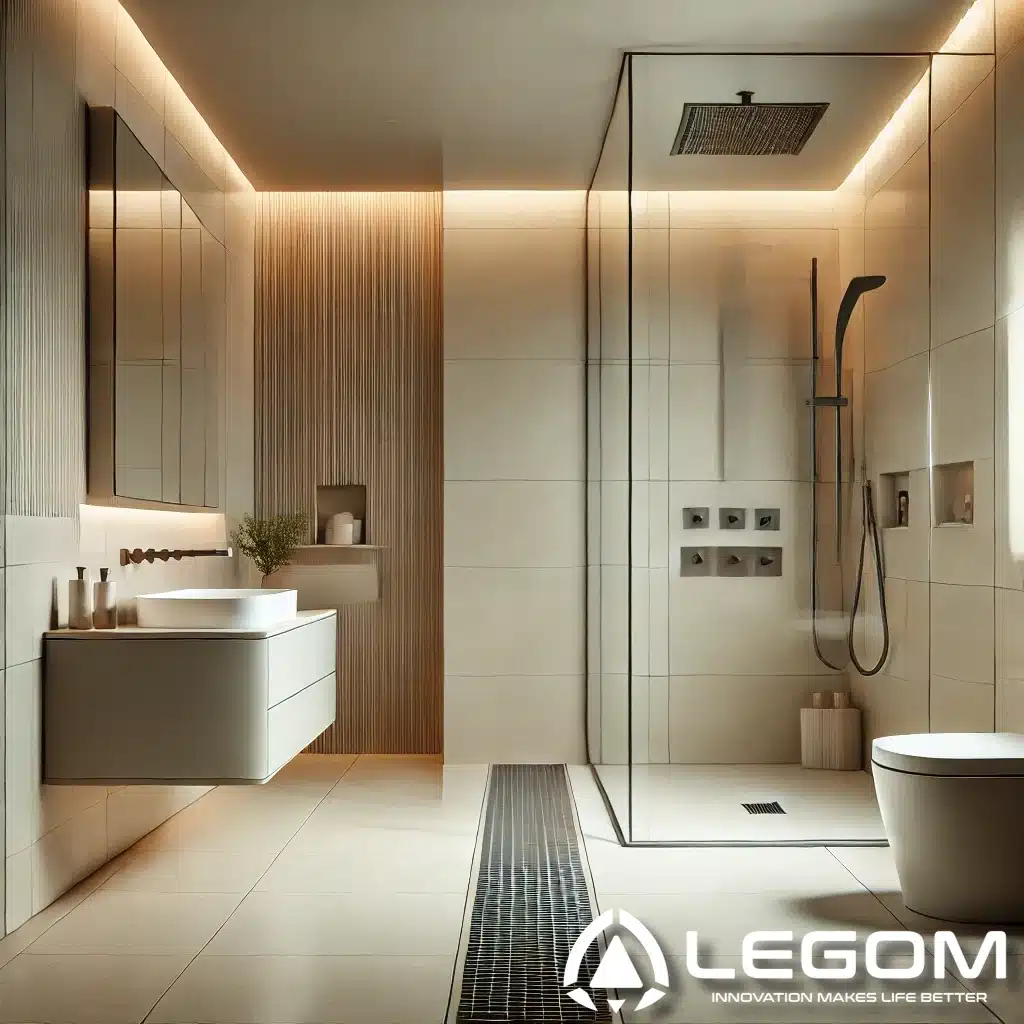
Creating wet room designs requires careful planning and execution to ensure the room is safe, functional, and durable. Before the details, some people may wonder what is a wet room? A wet room is a bathroom where the entire space is designed to be waterproof, with no partitions between the bathing area and the rest of the room. Hence, It is essential to ensure the proper slope of the floor towards the drain to prevent puddling. In addition, it’s important to consider the wet and dry zones. Good wet room designs also considers separating the space between the bathing and sink areas to reduce water spread. Definitely, we do not want to step in puddles when only using the sink areas, right?
That is why, an effective drainage system is a key element of wet room designs. Depending on the room size, the floor must have the correct slope, typically around 1 to 2 percent. Also we should provide high-quality drainage is crucial for managing large volumes of water. Linear drainage is often a favorite because it is efficient and can be installed along the walls or in the middle of the floor. The entire area must be protected with a waterproof membrane before tiles or other flooring materials are installed.
Contents
Crucial Parts in Wet Room Designs
Floor and wall materials, such as ceramic, porcelain, or natural stone, must be waterproof. Conservatively, we should avoid wooden materials because they easily absorb moist and water. Hence, it is prone to be damaged when the moisture content is high.
Meanwhile, applying a waterproof layer under the tiles will add extra protection against water leaks. Ensuring proper installation is critical to maintaining the durability and function of the wet room. Another crucial aspect of wet room designs is waterproofing the entire room. A waterproof membrane must be applied to all surfaces before installing tiles. Sealants should be used at all joints, especially in the corners and around the drain.
Adequate ventilation is also essential to keep the room dry and prevent dampness. An exhaust fan or mechanical ventilation system can help remove moisture effectively, preventing the build-up of dampness that can lead to mold growth.
Proper water pipe installation is vital to successful wet room designs. Hot and cold-water pipes must be installed correctly and insulated to prevent condensation and maintain water temperature.
Hiding pipes behind walls or under floors improves aesthetics, although access for maintenance must still be considered. Additionally, choosing appropriate features and accessories, such as showers and sinks that are resistant to high humidity, will extend the lifespan of the equipment in the wet room.
Maintenance
Planning for regular maintenance is essential to ensure the long-term success of wet room designs. Access doors or panels in key areas, such as pipe manifolds, will allow easy maintenance and repairs.
Routine inspections of pipes, drains, and sealants should be conducted to identify potential issues before they become serious. Ensuring compliance with local building codes is also a critical step in maintaining the safety and efficiency of your wet room. Using a certified professional will guarantee that the installation meets the required standards. Finally, choosing materials for your wet room is crucial for durability and functionality.
Pipe Recommendations for Wet Room Designs
In the four-seasons countries, modern wet rooms often include heating systems like hydronic underfloor heating, so the pipes need to perform well in both humid environments and heating applications. The most recommended types of pipes for these situations are PE-X, PE-RT, and PE-RT pipes with an oxygen barrier layer.
PE-X Pipe (Cross-Linked Polyethylene)
PE-X pipes are made from polyethylene with cross-linking, which adds extra strength and flexibility. Depending on the method used for cross-linking, you’ll find different types like PE-Xa, PE-Xb, and PE-Xc.
One big advantage of PE-X pipes is that they’re relatively easy to install and arrange during construction. They’re highly resistant to corrosion and chemicals, can handle high temperatures, and don’t absorb water—making them perfect for wet and humid environments.
That said, PE-X pipes do come with some downsides. They’re more expensive than PVC pipes and require special tools for heating and connecting during installation.
PE-RT Pipe (Polyethylene of Raised Temperature Resistance)
If you’re looking for a more flexible option, PE-RT pipes are worth considering. These pipes are designed to handle higher temperatures than standard polyethylene pipes and are more flexible than PE-X.
PE-RT pipes are easier to work with during installation because of their flexibility, and they’re also more affordable than PE-X pipes. However, they aren’t as resistant to chemicals and corrosion as PE-X, which makes them less ideal for environments with extreme conditions.
PE-RT-5 Layer Oxygen Barrier Pipe
For heating systems, especially those integrated into wet rooms, the PE-RT-5 layer oxygen barrier pipe stands out. It’s a PE-RT pipe with an additional oxygen barrier layer that prevents oxygen from seeping into the system. This feature is crucial because oxygen can cause corrosion in the metal parts of heating systems.
By blocking oxygen, this pipe helps extend the lifespan of the system. It’s also resistant to high temperatures, high pressure, and chemicals. On the downside, these pipes are more expensive than regular PE-X or PE-RT pipes. Installation requires extra care to avoid damaging the oxygen barrier layer.
Which Pipe is Best for Your Wet Room?
Choosing the right pipe depends on your specific needs and budget.
- If you need a pipe that can resist moisture and chemicals, PE-X is a reliable choice.
- For those looking for affordability and flexibility, PE-RT offers a good balance.
- If a heating system is part of your design, PE-RT with an oxygen barrier is the top option because it protects against oxidation, which can significantly extend the life of your heating system.
Good planning and the right materials are the foundation of any successful wet room design. By carefully selecting pipes that meet your wet room’s requirements, you can ensure both durability and functionality for years to come.
